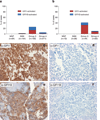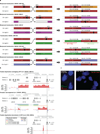Enhancer hijacking activates GFI1 family oncogenes in medulloblastoma
- PMID: 25043047
- PMCID: PMC4201514
- DOI: 10.1038/nature13379
Enhancer hijacking activates GFI1 family oncogenes in medulloblastoma
Abstract
Medulloblastoma is a highly malignant paediatric brain tumour currently treated with a combination of surgery, radiation and chemotherapy, posing a considerable burden of toxicity to the developing child. Genomics has illuminated the extensive intertumoral heterogeneity of medulloblastoma, identifying four distinct molecular subgroups. Group 3 and group 4 subgroup medulloblastomas account for most paediatric cases; yet, oncogenic drivers for these subtypes remain largely unidentified. Here we describe a series of prevalent, highly disparate genomic structural variants, restricted to groups 3 and 4, resulting in specific and mutually exclusive activation of the growth factor independent 1 family proto-oncogenes, GFI1 and GFI1B. Somatic structural variants juxtapose GFI1 or GFI1B coding sequences proximal to active enhancer elements, including super-enhancers, instigating oncogenic activity. Our results, supported by evidence from mouse models, identify GFI1 and GFI1B as prominent medulloblastoma oncogenes and implicate 'enhancer hijacking' as an efficient mechanism driving oncogene activation in a childhood cancer.
Figures















Comment in
-
When deletions gain functions: commandeering epigenetic mechanisms.Cancer Cell. 2014 Aug 11;26(2):160-1. doi: 10.1016/j.ccr.2014.07.021. Cancer Cell. 2014. PMID: 25117708 Free PMC article.
References
Supplementary References
-
- Richter J, et al. Recurrent mutation of the ID3 gene in Burkitt lymphoma identified by integrated genome, exome and transcriptome sequencing. Nat Genet. 2012;44:1316–1320. - PubMed
Publication types
MeSH terms
Substances
Grants and funding
LinkOut - more resources
Full Text Sources
Other Literature Sources
Molecular Biology Databases

